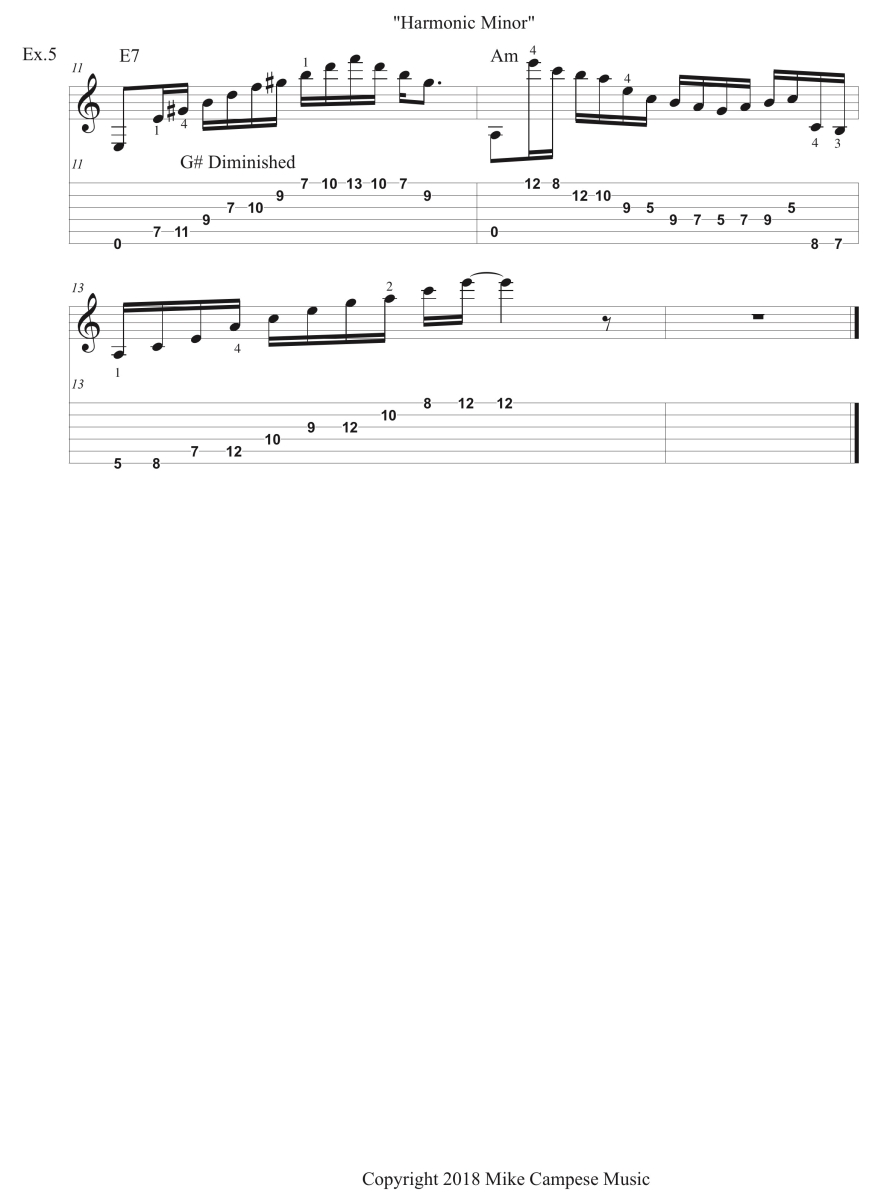Welcome back! They say this is the 100th column, wow! Summer is here, q new album is released and I’m getting ready for a European tour. A lot going on.
In this lesson I will be showing you how to unlock some sounds from the harmonic minor scale and how to use it as well. I have covered the harmonic minor in previous lessons, like the shapes, chords and modes, etc. For this lesson we will unlock some specific sounds, like the Phrygian dominant mode, diminished and augmented. We won’t go too far into detail, just some quick ways to get to other sounds and how you can apply them.
The harmonic minor scale is a minor scale with a raised 7th degree and the formula is (1, 2, b3, 4, 5, b6, 7), whole, half, whole, whole, half, augmented second, half. In the key of A, the notes are (A, B, C, D, E, F, G#).
It is important to play the harmonic minor all over the neck in every octaves, here is a 3 octave A harmonic minor scale in Example 1. Play this over a A minor chord to get the sound in your ear.
MP3 - Harmonic Minor (Unlocking Sounds) - Example 1
A very popular mode from the harmonic minor scale is the Phrygian Dominant scale, it is the 5th mode and the 5th is the dominant. The formula for this scale is (1, b2, 3, 4, 5, b6, b7) and in the A harmonic minor scale, the 5th is E. The notes in a E Phrygian Dominant scale are the same as the A harmonic minor scale (E, F, G#, A, B, C, D), it just depends what you emphasize. If you play Am and play the A harmonic minor scale it will sound like A harmonic minor, if you take the same notes of A harmonic minor and start with E and end with E, it will sound like E Phrygian Dominant. It is important to know this scale everywhere on the neck, in all keys and all octaves. Here is a 3 octave E Phrygian Dominant mode in Example 2. Play this over an E chord or E7th to get the sound in your ear.
MP3 - Harmonic Minor (Unlocking Sounds) - Example 2
If you harmonize the harmonic minor scale, there is a diminished chord built from the 2nd and the 7th degree. If you harmonize the scale with 7th chords, the 2nd chord of the scale is a min7th (b5), (1, b3, b5, b7) and the 7th chord is a Dim 7th. The Dim 7th is the most common in many styles, like classical, neoclassical, blues, jazz, etc. The formula is (1, b3, b5, bb7) and it is built with all minor 3rd intervals. The diminished 7th is symmetrical and it is built in minor 3rd intervals. You can also play it from the 4th and the b6th degree of the harmonic minor scale - you will notice it is the same notes in different places.
There are many ways you can apply the diminished arpeggio - a quick way is from the 5th degree of the harmonic minor scale. For example, If you are playing an E chord or E7th, the mode would be the E Phrygian Dominant scale. You can play your diminished arpeggio or chord from the 3rd, 5th, b7th and b9th of the E. For example, G# dim7, B dim7th, D dim7th, F dim7th over an E, E7th, or a E7th (b9), etc. This works in every key of course.
Also, augmented can be used as well and it is symmetrical like the diminished, but with major 3rd intervals. When you harmonize the harmonic minor with triads, the b3rd is augmented. For example, in A it will be a C augmented, which is the same notes as an E and G# augmented triad. The formula for the augmented triad is (1, 3, #5).
There are so many possibilities, I won’t go too crazy into the theory, the most important thing is to hear it. Here are some musical examples.
Example 3 is a line that is right inside of the A harmonic minor scale. It is based on a musical motif or pattern that moves down the neck in a few octaves. Play this over a Am chord to get the sound in your ear, and I use alternate picking for all of this.
MP3 - Harmonic Minor (Unlocking Sounds) - Example 3
Example 4 is a line from the E Phrygian Dominant scale and it is played over a E7th chord. In bar 2, there is a 6 note pattern that moves up the neck in 3 octaves, which is just the first 6 notes of the A harmonic minor. When you have the E in the bass, it is a E Phrygian Dominant sound.
MP3 - Harmonic Minor (Unlocking Sounds) - Example 4
Example 5 incorporates the diminished arpeggio, resolving to minor. The progression is E7 to Am, which is the five to one minor. In the first bar over the E7th, we are playing a G# diminished arpeggio. Then it resolves to A minor, using the notes from the A minor scale, (1, 2, b3, 4, 5, b6, b7). In Bar 3, there is an A minor 7th arpeggio that climbs up the neck.
MP3 - Harmonic Minor (Unlocking Sounds) - Example 5


OK, that is it for now! Be sure to make up your own examples and visit www.mikecampese.com for more information, CDs, swag and the new album release!
Mike Campese is an all-around music performer, session artist and teacher competent in many musical styles, electric and acoustic. He has studied at G.I.T. (Honors Graduate), and with Paul Gilbert, Norman Brown, Stanley Jordan, Scott Henderson and Keith Wyatt.